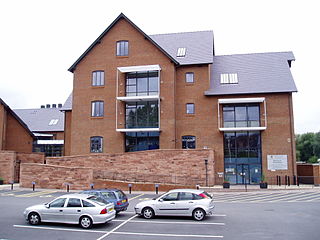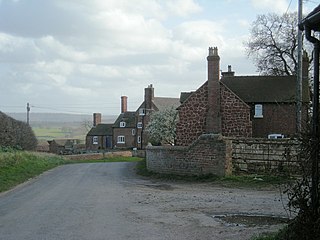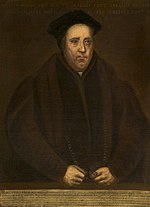
Shropshire is a landlocked historic county in the West Midlands region of England bordering Wales. Shropshire borders with the English counties of Cheshire to the north, Staffordshire to the east, Worcestershire to the southeast, and Herefordshire to the south, and bordering Wales with the counties of Wrexham and Powys to the west. A unitary authority of the same name was created in 2009, taking over from the previous county council and five district councils, now governed by Shropshire Council. The borough of Telford and Wrekin has been a separate unitary authority since 1998, but remains part of the ceremonial county.

Shrewsbury and Atcham was a local government district with borough status in Shropshire, England, between 1974 and 2009.

Wroxeter is a village in Shropshire, England, which forms part of the civil parish of Wroxeter and Uppington, beside the River Severn, 5 miles (8.0 km) south-east of Shrewsbury.

Attingham Park is an English country house and estate in Shropshire. Located near the village of Atcham, on the B4380 Shrewsbury to Wellington road. It is owned by the National Trust. It is a Grade I listed building.

Cressage is a village and civil parish in Shropshire, England. It lies on the junction of the A458 and B4380 roads and the River Severn flows around its northern boundary. The Royal Mail postcode begins SY5. The parish council is combined with the neighbouring parish of Sheinton.

Condover is a village and civil parish in Shropshire, England. It is about 5 miles (8 km) south of the county town of Shrewsbury, and just east of the A49. The Cound Brook flows through the village on its way from the Stretton Hills to a confluence with the River Severn. Condover is near to the villages of Dorrington, Bayston Hill and Berrington. The population of the Condover parish was estimated as 1,972 for 2008, of which an estimated 659 live in the village of Condover itself. The actual population measured at the 2011 census had fallen to 1,957.

Frankwell is a district of the town of Shrewsbury, in Shropshire, England. It lies adjacent to the River Severn, to the northwest of the town centre, and is one of Shrewsbury's oldest suburbs. The main road running through the area is also called Frankwell.
The town of Shrewsbury in Shropshire, England, has a history that extends back at least as far as the year 901, but it could have been first settled earlier. During the early Middle Ages, the town was a centre of the wool trade, and this was a peak in its importance. During the Industrial Revolution, comparatively little development took place in the town, although it did serve as a significant railway town after the development of rail transport in the area. The town today retains much of its historic architecture.

Baron Berwick, of Attingham Park in the County of Shropshire, was a title in the Peerage of Great Britain. It was created in 1784 for Noel Hill, who had earlier represented Shrewsbury and Shropshire in Parliament. He was the son of Thomas Hill, son of Thomas Harwood, a draper, of Shrewsbury, Shropshire. His paternal grandmother was Margaret, daughter of Rowland Hill, sister of Sir Richard Hill and aunt of Sir Rowland Hill, 1st Baronet, ancestor of the Viscounts Hill. Hill's father had assumed the surname of Hill in lieu of his patronymic on succeeding to the Hill estates through his mother. Lord Berwick was succeeded by his eldest son, the second Baron. He was a patron of art. He died childless and was succeeded by his younger brother, the third Baron. He was a diplomat and politician. In 1824 he assumed by Royal licence the additional surname of Noel, which was that of his maternal grandfather, William Noel, younger son of Sir John Noel, 4th Baronet, of Kirkby Mallory.

Eyton on Severn is a small village in the English county of Shropshire, east of Shrewsbury. It is located on a ridge above the northern bank of the River Severn. The significant tributary of the Cound Brook joins the Severn at Eyton, albeit on the opposite bank. Wroxeter, the village located at a ruined Roman city, is only a mile north-west of the village. The hamlet of Dryton is just east of Eyton. All lie in the parish of Wroxeter and Uppington.

Cound is a village and civil parish on the west bank of the River Severn in the English county of Shropshire, about 7 miles south east of the county town Shrewsbury. Once a busy and industrious river port Cound has now reverted to a quiet rural community and dormitory village, for commuters to the commercial centres of Shrewsbury and Telford.

Uppington is a village in the English county of Shropshire. It lies in the civil parish of Wroxeter and Uppington. It is situated 7.5 miles East from Shrewsbury and 4 miles South-East from Wellington. It is located within the Diocese of Lichfield, within the Rural Deanery of Wrockwardine. Uppington covers a total area of around 706 acres, much of this being open fields, used for arable and pastoral farming, as well as a small amount of local woodland.

Cronkhill, Atcham, Shropshire, designed by John Nash, is "the earliest Italianate villa in England".

Richard Hill of Hawkstone Hall, Shropshire, was baptised at Hodnet, Shropshire, on 23 March 1655 and died unmarried at Richmond, Surrey, on 11 June 1727, aged 72. He was known as 'the Great Hill', diplomatist, public servant and statesman, who accumulated great wealth through a series of profitable appointments and judicious dealings.

Wroxeter and Uppington is a civil parish in the English county of Shropshire. The population of the Civil Parish at the 2011 census was 382. It lies mainly between the River Severn and the old A5 and stretches from Atcham to The Wrekin.

Shrewsbury is a market town, civil parish, and the county town of Shropshire, England, on the River Severn, 150 miles (240 km) north-west of London. At the 2021 census, it had a population of 76,782.
Richard Noel-Hill, 4th Baron Berwick of Attingham, was born in the parish of St. Martin-in-the-Fields, Covent Garden, London, England, and baptised there on 11 November.

St Eata's Church is in the village of Atcham, Shropshire, England. It is an active Anglican parish church in the deanery of Shrewsbury, the archdeaconry of Salop, and the diocese of Lichfield. Its benefice is united with that of St Giles-with-Sutton, Shrewsbury. The church is recorded in the National Heritage List for England as a designated Grade I listed building. Its dedication to Eata of Hexham is unique.

Shrewsbury Museum and Art Gallery was founded in 1835 as the Museum of the Shropshire and North Wales Natural History and Antiquarian Society Society in Dogpole, Shrewsbury, England. In 1853 the collections were moved to Vaughan's Mansion on College Hill, which became known as the Shropshire and North Wales Museum. After 160 years and two subsequent homes the museum returned to Vaughan's Mansion and the Music Hall Complex after a major redevelopment of the site.
Atcham is a civil parish in Shropshire, England. It contains 67 listed buildings that are recorded in the National Heritage List for England. Of these, four are listed at Grade I, the highest of the three grades, six at Grade II*, the middle grade, and the others are at Grade II, the lowest grade. The parish contains the village of Atcham and the surrounding countryside. In the parish are three country houses; each of these is listed at Grade I, and they are associated with a number of other listed buildings in the surrounding grounds. The other Grade I listed building is the parish church, and items in the churchyard are also listed. The Severn River runs through the parish and the older bridge crossing it is listed. Also listed is a bridge crossing a disused branch of the Shropshire Union Canal. The other listed buildings include houses and cottages in the village and countryside, farmhouses and farm buildings, two milestones, and a telephone kiosk.




















